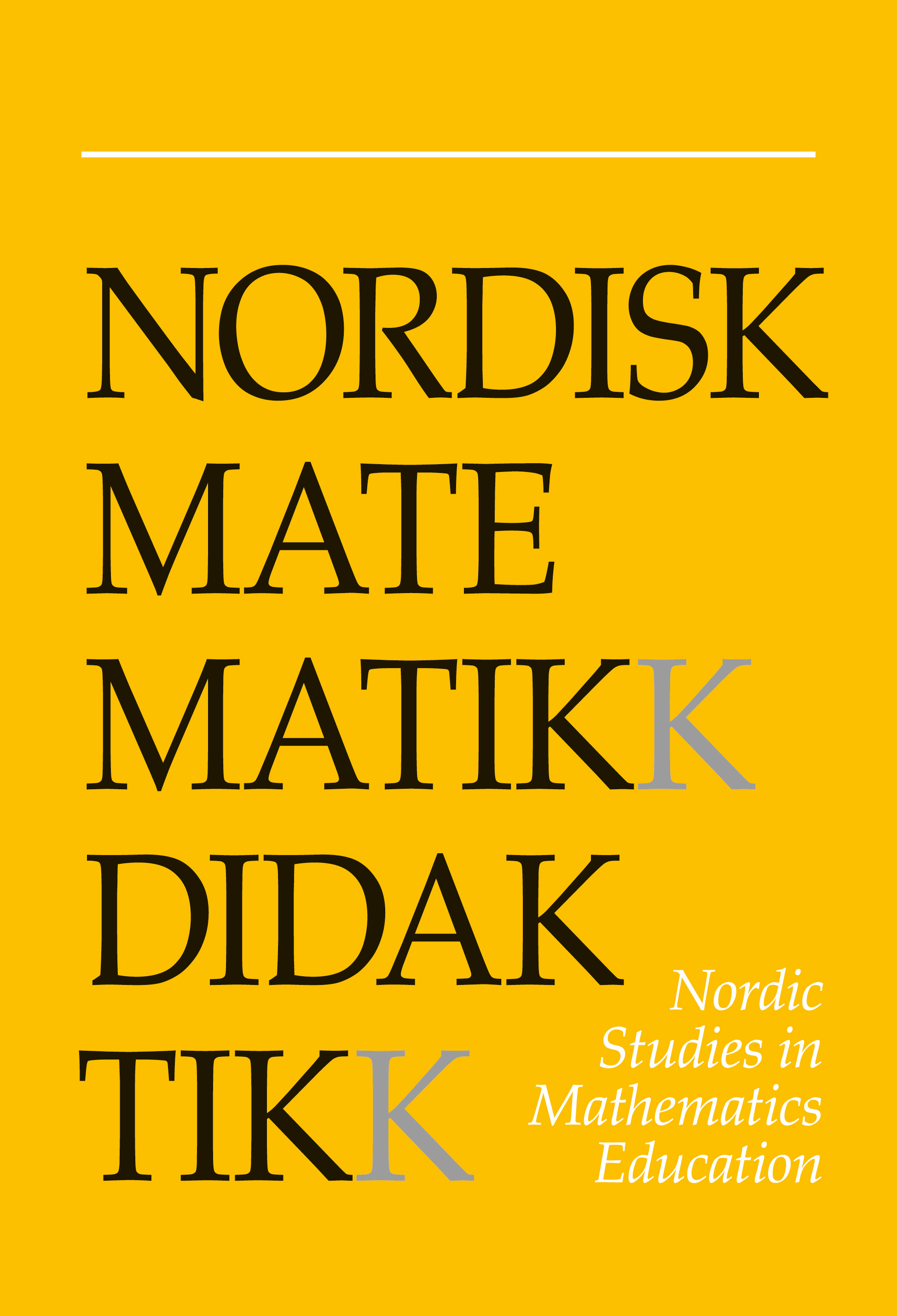What the teachers and the students do and how they interact – a comparison of special education teaching and ordinary teaching in mathematics
DOI:
https://doi.org/10.7146/nomad.v25i3-4.149070Abstract
In this article, I compare three teaching situations: ordinary mathematics teaching, special education teaching in mathematics located within the ordinary class, and special education teaching in mathematics located outside the ordinary class, in order to find the main differences between them with respect to what the teacher and the students do. The findings are discussed in light of various aspects of the inclusion concept. The empirical material has been collected in the SPEED-project and consists of observations throughout an entire school day of 108 individual students, their teachers and the classes they belong to. The discussion reveals that the special education teaching is more individual, the student is more frequently engaged in subject-related activities and in communication with the teacher, and that each of the two different organizational forms of the special education teaching in mathematics separately seem to fulfil different aspects of the concept of inclusion in a best way.
References
Asp-Onsjö, L. (2006). Åtgärdsprogram - dokument eller verktyg? En fallstudie i en kommun. Göteborgs Univeristet.
Cohen, J. (1988). Statistical power analysis for the behavior sciences. Psychology Press Taylor & Francis Group.
Egelund, N., Haug, P. & Persson, B. (2006). Inkluderande pedagogik i skandinaviskt perspektiv. Liber.
Eikrem, B. O., Grimstad, B. F., Opsvik, F., Skorpen, L. B. & Topphol, A. K. (2012). Åleine eller saman? Ein studie av arbeidsmåtar i norsk, matematikk og engelsk. In P. Haug (Ed.), Kvalitet i opplæringa. Arbeid i grunnskulen, observert og vurdert (pp. 77-100). Det Norske Samlaget.
Field, A. (2018). Discovering statistics using IBM SPSS statistics (5th ed.). Sage.
Florian, L. & Rouse, M. (2001). Inclusive practice in English secondary schools: lessons learned. Cambridge Journal of Education, 31 (3), 399-412. https://doi.org/10.1080/03057640120086648
Hattie, J. (2009). Visible learning: a synthesis of over 800 meta-analyses relating to achievement. Routledge.
Haug, P. (2014). The practices of dealing with children with special needs in school: a Norwegian perspective. Emotional and Behavioral Difficulties, 19 (3), 296-310. https://doi.org/10.1080/13632752.2014.883788
Haug, P. (2015). Spesialundervisning og ordinær opplæring. Nordisk tidsskrift for pedagogikk og kritikk, 1 (1), 1-14. https://doi.org/10.17585/ntpk.v1.121
Haug, P. (2017a). Understanding inclusive education: ideals and reality. Scandinavian Journal of Disability Research, 19 (3), 206-217. https://doi.org/10.1080/15017419.2016.1224778
Haug, P. (Ed.) (2006). Begynnaropplæring og tilpassa undervisning - kva skjer i klasserommet? Caspar Forlag.
Haug, P. (Ed.) (2012). Kvalitet i opplæringa. Arbeid i grunnskulen, observert og vurdert. Det Norske Samlaget.
Haug, P. (Ed.) (2017b). Spesialundervisning, innhald og funksjon. Det Norske Samlaget.
Klafki, W. (2001). Dannelsesteori og didaktik: nye studier. Klim.
Klette, K. (Ed.) (2003). Klasserommets praksisformer etter Reform 97. Pedagogisk forskingsintitutt.
KUF. (1996). Læreplanverket for den 10-årige grunnskolen. Det kongelige kirke-, utdannings- og forskingsdepartementet.
LK06. (2006). Læreplanverket for kunnskapsløftet (Midlertidig utgave, juni 2006). Utdanningsdirektoratet.
Lunde, O. (2010). Hvorfor tall går i ball - matematikkvansker i et spesialpedagogisk fokus. Info Vest forlag.
Markussen, E., Strømstad, M., Carlsen, T. C., Hausstätter, R. & Nordahl, T. (2007). Inkluderende spesialundervisning? (Report 19-2007). NIFU STEP. hdl.handle.net/11250/279073
Mellin-Olsen, S. (1996a). Oppgavediskursen i matematikk. Tangenten, 7 (2), 9-15.
Mellin-Olsen, S. (1996b). Samtalen som forskingsmetode. Tekster om kvalitativ forskingsmetode som del av pedagogisk virksomhet. Caspar Forlag.
Niss, M. (2007). Opgavediskursen i matematikundervisningen. MONA - Matematik- og Naturfagsdidaktik, 1, 7-17.
Niss, M. & Højgaard Jensen, T. (2002). Kompetencer og matematiklæring: ideer og inspiration til udvikling af matematikundervisning i Danmark. Undervisningsministeriet.
Nordahl, T. & Hausstätter, R. S. (2009). Spesialundervisningens forutsetninger, innsatser og resultater (Report 9-2009). Høgskolen i Hedmark. hdl.handle.net/11250/133864
Opplæringslova (2005). Lov om grunnskolen og den vidaregåande opplæringa. https://lovdata.no/dokument/NL/lov/1998-07-17-61#KAPITTEL_6
Powell, J., Martindale, A. & Kulp, S. (1975). An evaluation of time-sample measures of behavior. Journal of applied behavior analyses, 8 (4), 463-469. https://doi.org/10.1901/jaba.1975.8-463
Shulman, L. S. (2005). Signature pedagogies in the professions. Daedalus, 134 (3), 52-59. https://doi.org/10.1162/0011526054622015
Skorpen, L. B. (2006). Kunnskapstypar og arbeidsformer i matematikk i begynnaropplæringa. In P. Haug (Ed.), Begynnaropplæring og tilpassa opplæring (pp. 115-151). Caspar Forlag.
Skorpen, L. B. (2009). Nokre spesielle trekk ved arbeidet med matematikkfaget i begynnaropplæringa. Nordisk matematikkdidaktikk, 14 (3), 7-32.
SPEED (2013). Speed-prosjektet. hivolda.no/Forsking/Forskingsprosjekt/speed-prosjektet
Stigler, J. W. & Hiebert, J. (1999). The teaching gap: best ideas from the world's teachers for improving education in the classroom. Free Press.
Topphol, A. K. (2012). "Da klokka klang ..." - om timesignaturane i matematikk og naturfag. In P. Haug (Ed.), Kvalitet i opplæringa. Arbeid i grunnskulen observert og vurdert (pp. 122-143). Det Norske Samlaget.
Topphol, A. K., Haug, P. & Nordahl, T. (2017). SPEED-prosjektet, metode, datagrunnlag og prosedyrar. In P. Haug (Ed.), Spesialundervisning, innhald og funksjon (pp. 31-51). Det Norske Samlaget.
UNESCO (1994). The Salamanca statement and framework for action on special needs education. Paper presented at the World conference on special needs education: access and quality, Salamanca, Spain.
Utdanningsdirektoratet (2018). Grunnskolens Informasjonssystem (GSI). Utdanningsdirektoratet. https://gsi.udir.no/app/#!/view/units/collectionset/1/collection/80/unit/1/
Whitty, E. & Clarke, M. (2012). Irish mathematics teachers' attitudes towards inclusion. European journal of special needs education, 27 (2), 237-256. https://doi.org/10.1080/08856257.2012.669112
Downloads
Published
How to Cite
Issue
Section
License

This work is licensed under a Creative Commons Attribution-NonCommercial-ShareAlike 4.0 International License.



